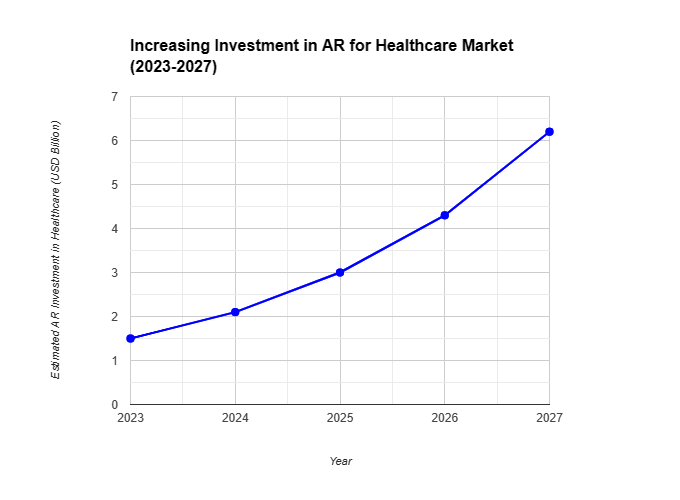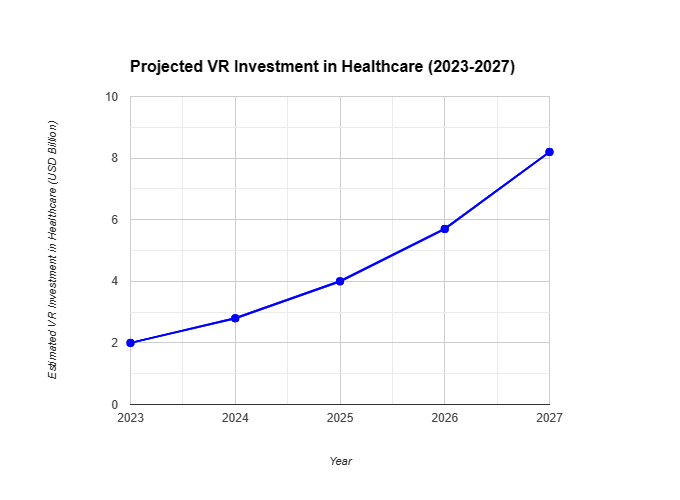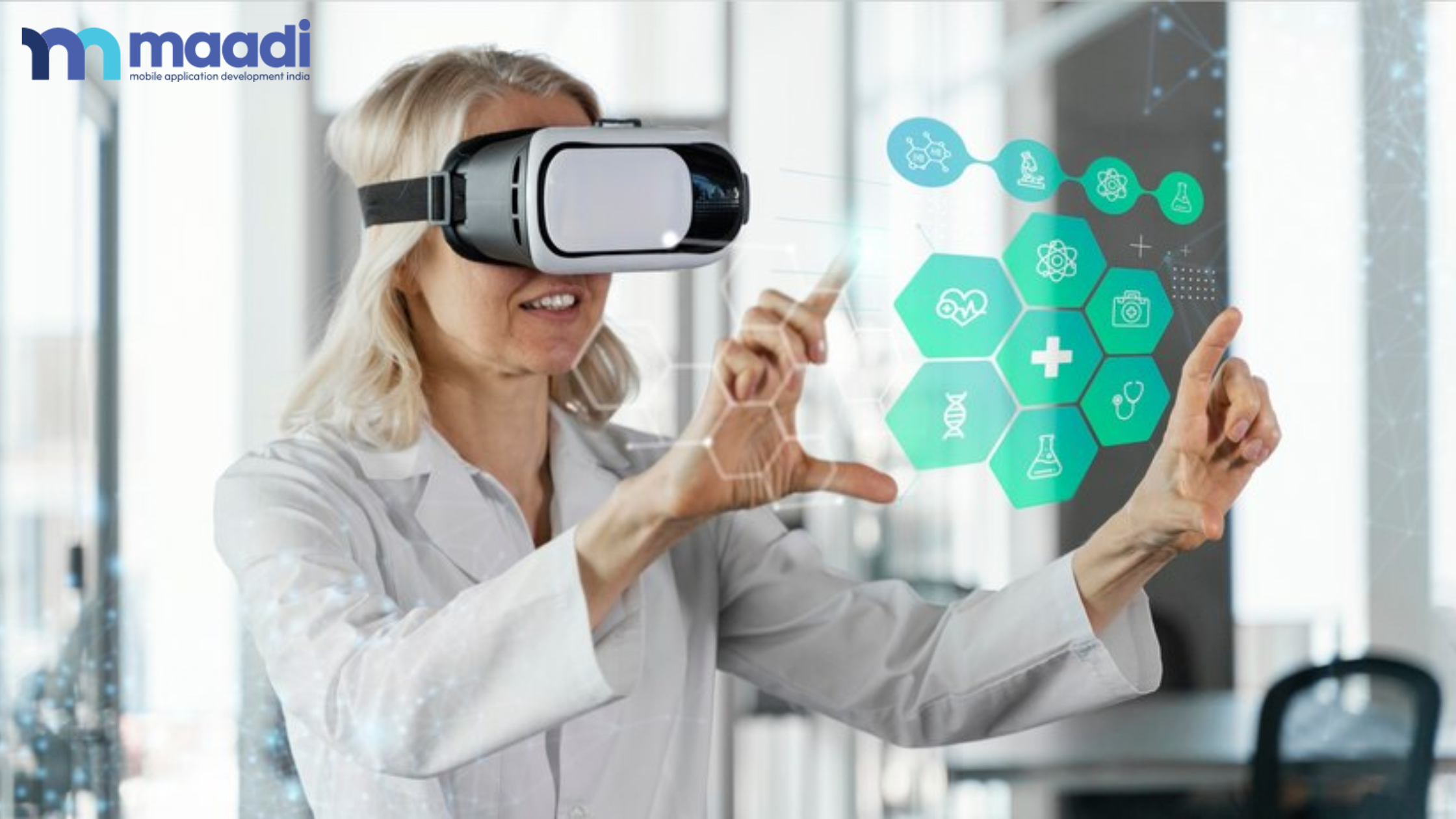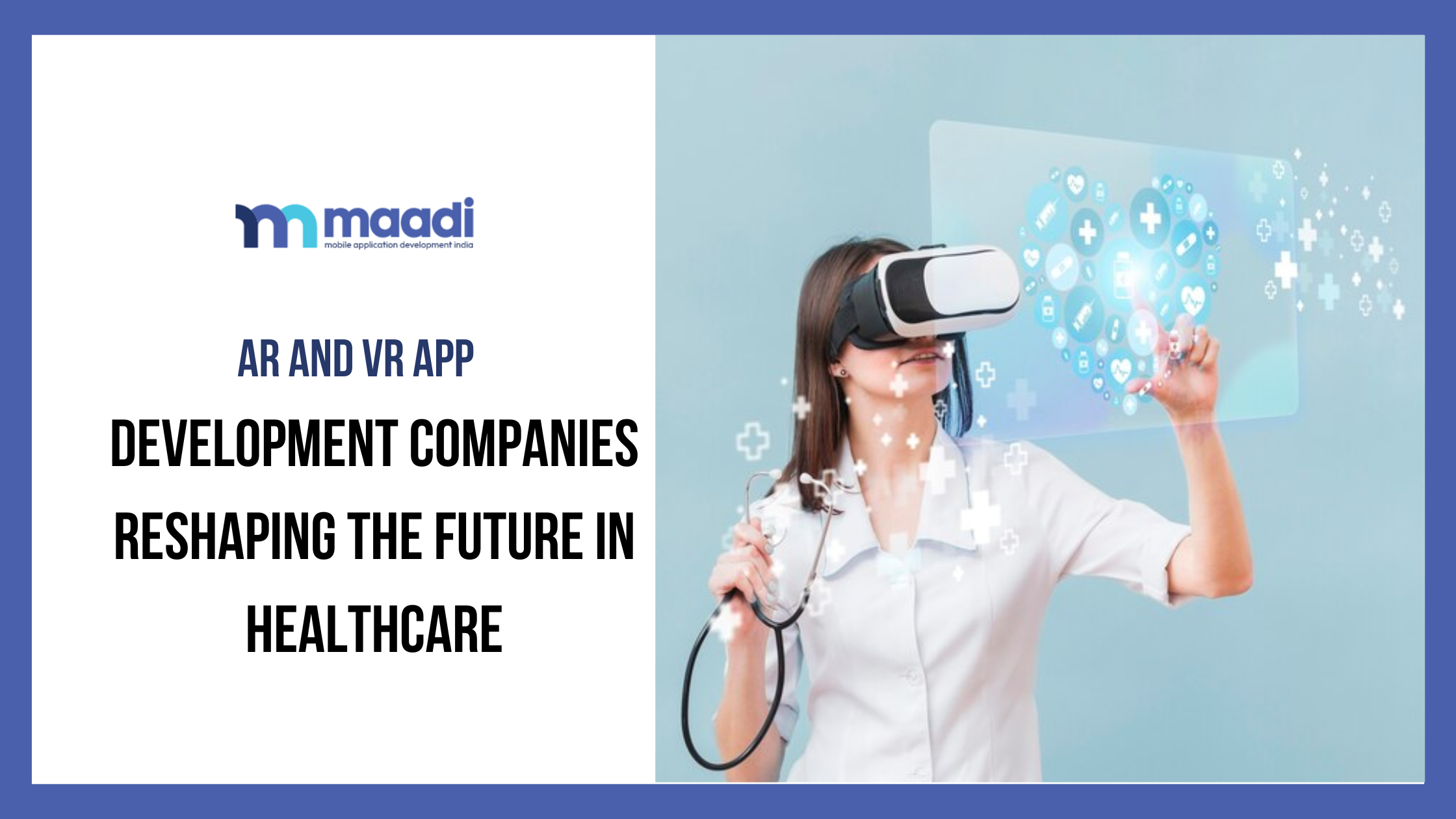Healthcare and medical communities are always searching for new technology to enable better patient care and precise medical practices. AR and VR in healthcare is a growing trend that will bring in a new era of enhanced diagnostics and surgical procedures.
The official U.S. Food and Drug Administration (FDA) also provided a detailed understanding of AR and VR in healthcare. With the growing demand, businesses are investing in AR and VR app development to create innovative solutions for healthcare and the medical field. In this article, we will provide more information on how the future of AR and VR in healthcare will help doctors and patients alike.
We explained various applications of both AR and VR for the medical field, explained benefits, and listed trends. As a leading AR and VR app development company in India, we understand the importance of it and explain the details with better accuracy and simple terms.
Statistics for AR and VR in Healthcare Market 2024
- The global AR and VR in healthcare market is projected to reach USD 11.92 billion by 2027, indicating a CAGR of 32.33% from 2023 to 2028. (Source: MarketDataForecast, 2023)
- The VR segment is expected to dominate, reaching USD 6.85 billion by 2027, driven by advancements in mental health and pain management applications. (Source: MarketDataForecast, 2023)
- VC funding in AR and VR healthcare startups reached USD 750 million in the first half of 2023, showcasing continued investor interest. (Source: Mercom Capital Group, 2023)
- A 2023 survey by Statista found that over 80% of physicians in the US believe VR will positively impact patient outcomes.
- The FDA approved 20 AR and VR medical devices in 2023, highlighting regulatory support for the technology. This is a significant increase compared to previous years. (Source: Statista, 2023)
- Over 150 medical schools are now using VR simulations worldwide, improving surgical and procedural skills training. (Source: XR Health, 2023)
The Role of AR in Healthcare App Development
Augmented Reality is an integral part of healthcare app development. It transforms the way that medical information is presented and improves the user experience. With AR, medical information can be visualized and interacted with in a new, innovative way. Here is how AR can help with the healthcare industry in the future.

Data Visualization and Virtual Anatomy
Healthcare app development can benefit significantly from Augmented Reality technology. AR can help medical professionals visualize complex medical data and anatomical structures in 3D, which can be overlaid in the real world. This technology is very useful for diagnostics, as it allows physicians to see detailed patient information in context, which can improve the accuracy of their diagnoses.
AR medical devices can also help healthcare professionals explore virtual anatomy, allowing them to interact with digital representations of anatomical structures, improving their understanding and, ultimately, the care they provide for patients.
Accelerated Learning Curve for Medical Professionals
AR technology in healthcare apps can help medical professionals learn faster and better. AR improves their training and education by displaying relevant information and guidance in real time.
AR in healthcare services provides medical data, procedural instructions, and other important information when needed, making hands-on training sessions more efficient and effective.
As a result, medical professionals can acquire and refine their skills quickly, leading to better patient care.
Patient Care and Treatment through AR Applications
Augmented Reality applications are changing the way healthcare professionals diagnose and plan treatments for their patients. These innovative tools provide real-time information during patient examinations, enabling accurate and timely assessments.
AR also helps improve patient engagement by offering personalized treatment plans and educational materials.
Augmented reality technology in healthcare enhances the patient’s experience and ensures a more informed and collaborative approach between healthcare providers and patients, leading to better treatment outcomes.
Augmented Surgical Procedures
The use of Augmented Reality in healthcare transforms surgical procedures by providing more insights and guidance to surgeons before and during operations. AR healthcare app integration significantly improves surgical planning and navigation by offering a real-time overlay of relevant data onto the surgical field.
Applications of AR in Clinical Practice provide precision and accuracy during complex surgeries, ultimately leading to better decision-making, increased confidence among surgical teams, and better patient outcomes.
The Impact of VR in Healthcare App Development
VR technology transforms healthcare app development, making it easier for healthcare professionals to communicate with patients by presenting medical content more interactively and engagingly.

Rehabilitation and Physical Therapy through VR
Virtual Reality is becoming increasingly important in the development of healthcare applications, particularly in rehabilitation and physical therapy. VR apps create a captivating environment for patients undergoing rehabilitation, providing interactive and stimulating exercises.
These exercises can be customized to meet specific therapeutic needs, encouraging patients to actively participate in their recovery.
By simulating real-world scenarios, the future of virtual Reality in healthcare will improve physical therapy sessions, leading to more effective rehabilitation and better outcomes for patients.
Pain Management and Distraction
VR Technology in healthcare settings emerges as a valuable tool for pain management and distraction therapy. By immersing patients in virtual environments that are engaging and visually captivating, VR effectively diverts attention away from pain and discomfort during medical procedures.
VR healthcare uses cases that allow innovative approaches to pain management to not only improve the patient’s experience but also contribute to reduced anxiety, stress, and pain perception.
VR’s ability to create a therapeutic distraction holds great promise in improving patients’ overall well-being undergoing various medical treatments.
Psychological Therapy and Rehabilitation
VR Therapy in Medicine is changing the way we approach psychological therapy and rehabilitation. By using virtual environments, people can participate in therapeutic experiences that are designed to address mental health issues like anxiety, phobias, and Post-Traumatic Stress Disorder (PTSD).
VR healthcare applications can help create controlled situations for exposure therapy, which allows patients to confront and manage psychological challenges in a safe and captivating way.
VR for patient care offers a new way to treat mental health, providing a personalized and effective tool for psychological therapy and rehabilitation.
Patient Education and Engagement
Virtual Reality applications are important tools for educating and engaging patients. They provide interactive experiences that help patients understand complex medical concepts, such as their own anatomy, medical procedures, and treatment plans.
The future of VR in healthcare will allow patients to make informed decisions and participate actively in their healthcare journey. VR’s visually compelling approach also facilitates communication between healthcare providers and patients. Ultimately, this leads to better decision-making and a more satisfying healthcare experience.
Immersive Training and Education
Virtual Reality medical training and education in healthcare will offer immersive and realistic simulations. Medical professionals can engage in virtual training sessions that replicate real-world scenarios, allowing for hands-on practice in a risk-free environment.
Medical VR training programs will enhance the development of skills and competencies, from surgical procedures to emergency response. Its potential to create authentic learning experiences contributes to a more confident and proficient healthcare workforce, ultimately benefiting patient care and safety.
Improving Patient Experience through Immersive Healthcare Solutions
Healthcare integrated with VR technology will revolutionize patient experience by offering healthcare solutions that are more captivating than traditional methods. Through VR applications, patients can escape the clinical environment and enter calming virtual spaces, reducing anxiety and stress related to medical procedures.
Virtual Reality mental health treatment is used for pain management, therapeutic distraction, and creating virtual wellness experiences to improve the overall patient experience by prioritizing comfort and well-being.
VR-Based therapeutic interventions contribute to a more positive perception of healthcare encounters, promoting patient satisfaction and a sense of control over their healthcare journey.

Benefiting Using AR and VR App Development in Healthcare
AR and VR technology can significantly improve medical experiences by making them more interactive, visual, and personalized. This is especially beneficial for healthcare, as it can improve the quality of care and provide better outcomes for patients. Here are some of the benefits of AR and VR applications for healthcare.
Improved Diagnosis and Treatment Planning
Augmented Reality and Virtual Reality in the medical field can help healthcare professionals with diagnosis and treatment planning. AR can show medical data during examinations in real time, making it easier for doctors to make informed decisions.
VR provides a 3D and compelling platform to plan treatments with more precision. By combining AR and VR, healthcare professionals can streamline diagnostics and improve treatment planning, which can ultimately lead to better patient outcomes.
Enhanced Patient Engagement and Compliance
Using AR and VR applications can help healthcare providers improve patient engagement and compliance. By providing interactive and personalized experiences, patients can be better informed and involved in the treatment process.
AR in healthcare services can assist in creating treatment plans by offering real-time, augmented information that is easy for patients to understand. AR apps can improve communication between healthcare providers and patients and encourage active participation in the decision-making process.
Similarly, VR healthcare solutions can provide compelling educational content and therapeutic experiences to help patients better understand their conditions. This results in increased compliance with treatment plans and improved overall health outcomes.
Cost-Effective Solutions for Medical Training
AR/VR Simulation for healthcare education made medical training more affordable and efficient. They have revolutionized the way healthcare professionals learn and refine their skills.
Hands-on training with augmented displays using AR applications has made it possible to reduce the need for costly physical models and cadavers. This has also created a more interactive and dynamic learning environment. VR technology has made realistic simulations of real-world scenarios possible, which is a more cost-effective alternative to traditional training methods.
The accessibility and scalability of AR and VR in medical training have made skill development in healthcare more efficient and economically viable.
Advanced Remote Consultations and Collaborations
The use of AR and VR technology in healthcare helps professionals to collaborate remotely across distances. AR healthcare software allows professionals to share real-time augmented information during virtual meetings, enabling them to make collaborative decisions without being physically present.
On the other hand, medical virtual reality applications create virtual spaces where medical teams can interact with 3D models and data collaboratively. These technologies can improve remote patient care by enhancing consultation efficiency, promoting interdisciplinary collaborations, and providing timely access to expertise.
This integration of AR and VR in remote healthcare consultations signifies a shift towards more inclusive and collaborative healthcare practices.
Real World Use Cases of AR and VR in Healthcare
| Company Name |
Product Name |
Technology |
Use Case |
| AccuVein |
AccuVein AR |
AR |
Projects a vein map onto the patient’s skin for easier blood draws and IV insertions. |
| XRHealth |
XRHealth VR Therapy |
VR |
Provides immersive virtual environments for treating anxiety, depression, and other mental health conditions. |
| Osso VR |
Osso VR Surgical Training Platform |
VR |
Simulates complex surgical procedures in VR for surgeons to practice and improve their skills. |
| Stryker |
Surgeon Connect |
AR |
Overlays medical images and data onto the patient during surgery for improved guidance and decision-making. |
| Philips Healthcare |
Zoom |
AR |
Guides minimally invasive procedures with real-time ultrasound imaging overlaid on the patient’s anatomy. |
Future Trends in AR and VR Healthcare Application
Discover the innovative and improved user experiences in the medical field that will be offered through Augmented Reality and Virtual Reality applications.
1.Merging of AR/VR with Other Emerging Technologies
The future of healthcare aims to seamlessly integrate Augmented Reality and Virtual Reality with other advanced technologies. This convergence can lead to more responsive healthcare experiences for patients and practitioners.
Real-time data processing and connectivity can be enhanced by combining AR/VR with technologies such as 5G, edge computing, and the Internet of Things (IoT). The future of AR and VR in healthcare can enable practitioners to access patient data instantly, fostering a new era of connected and data-driven healthcare solutions.
2. Improved Precision and Minimally Invasive Procedures
Future trends in AR and VR in Healthcare are poised to transform medical procedures, especially minimally invasive surgeries. AR surgical training enhances surgical precision by overlaying digital information in the surgical field.
Medical VR training program’s compelling planning environments allow for more accurate and targeted interventions. Surgeons are likely to incorporate these technologies into their practices, leading to advancements in precision medicine and less invasive medical procedures.
3.Personalized Medicine and Patient Engagement
AR and VR healthcare applications will change the way we utilize prescriptions and medicine. Newer technologies are changing traditional ways of providing healthcare services.
They offer innovative solutions that cater to the individual needs of patients. Augmented Reality lets healthcare professionals use digital information to visually enhance medical data, helping them adjust treatments more accurately.
On the other hand, Virtual Reality provides mesmerizing experiences that can help patients better understand complex medical conditions and treatment plans. It can also engage patients by providing interactive educational platforms.
4.AR-Assisted Home Care
Future healthcare applications of AR technology can extend healthcare services to patients in their homes. Patients will be able to manage their health with AR applications that provide step-by-step instructions or monitor their vital signs in real-time.
This shift towards AR-assisted home care promotes patient independence, reduces the burden on healthcare systems, and enhances access to medical guidance. As AR technology becomes more user-friendly, it can improve healthcare delivery by providing personalized and accessible medical guidance to individuals in the comfort of their homes.
5.AI Integration and Advanced Analytics
In the future, healthcare will combine Artificial Intelligence with AR and VR to create advanced analytics and intelligent decision support systems. This integration will improve diagnostics and treatment plans by providing real-time insights, analyzing large amounts of data, and predicting potential health outcomes.
By working together, AI and AR/VR will bring in a new era of data-driven healthcare, optimizing patient care pathways and contributing to more efficient and effective healthcare delivery.
Conclusion
After the pandemic, it became evident that remote consultation and diagnosis are not only required but also a necessity. Emerging trends can help offer new and mesmerizing solutions that allow doctors to consult with patients and offer accurate diagnoses.
AR and VR in healthcare can create opportunities where medical professionals can observe data in virtual environments to get a better picture. In this blog, we have provided information on how AR and VR healthcare applications will work alongside medical communities to offer better solutions.
Our goal is to provide information on the future of AR and VR applications in healthcare and how they will better transform the field of medicine.
Why Choose MAADI for AR and VR App Development?
We are a leading mobile app development company that leverages emerging technology to offer advanced services. As a prominent AR and VR development company in India, we provide a wide range of use cases for businesses to adopt, which will streamline their operation and improve productivity. Our AR and VR developers understand the requirements and offer cutting-edge applications that can transform industries and help their customers.
FAQ
What is the future of AR VR in the healthcare industry?
AR and VR technology is opening up a world of possibilities for healthcare. For example, surgeons can now project real-time patient data onto their field of vision during surgery. Therapists can use virtual environments to help patients manage anxiety. And communities in remote areas can access specialist medical consultations through telemedicine. These are just a few examples of how AR and VR could transform healthcare in the future.
How can we use AR and VR in healthcare?
Healthcare professionals can benefit from using AR and VR technologies. AR can help them during surgery by overlaying medical images on the patient and providing guidance for minimally invasive procedures. It can even translate medical jargon to help patients understand better. VR can be used to manage pain by transporting patients to calming virtual landscapes. It can also be used for phobia exposure therapy and gamified physical therapy to make rehabilitation more engaging and effective.
What are the real-world use cases using AR and VR technology in healthcare?
AR and VR healthcare applications are already making significant differences. AccuVein has developed an AR healthcare app that can project vain maps on patients. XRHealth has created a VR app for healthcare that can treat anxiety, depression, and other mental health conditions. For Virtual Reality Surgical Training, Osso VR has created a system.
How will AR and VR be used in medical training?
Medical training is about to change with the introduction of AR and VR. These technologies will allow medical students to practice surgeries on virtual patients, experience the world from a patient’s perspective, and study anatomy in 3D, all within a safe virtual environment. This type of mesmerizing learning will help students better retain knowledge and become more skilled and compassionate healthcare providers in the future.



